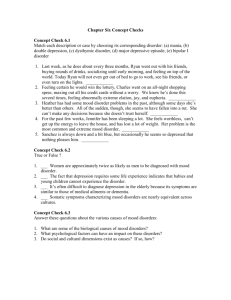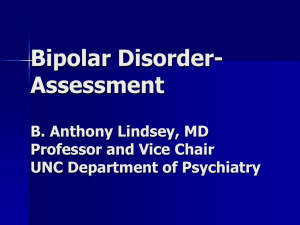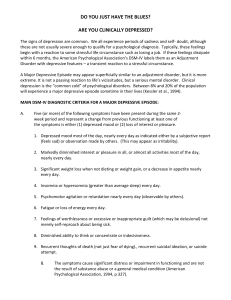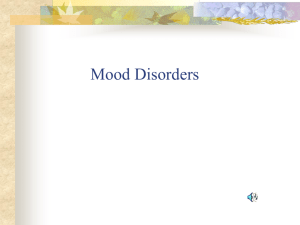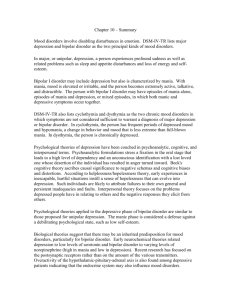Depressive Disorders
advertisement
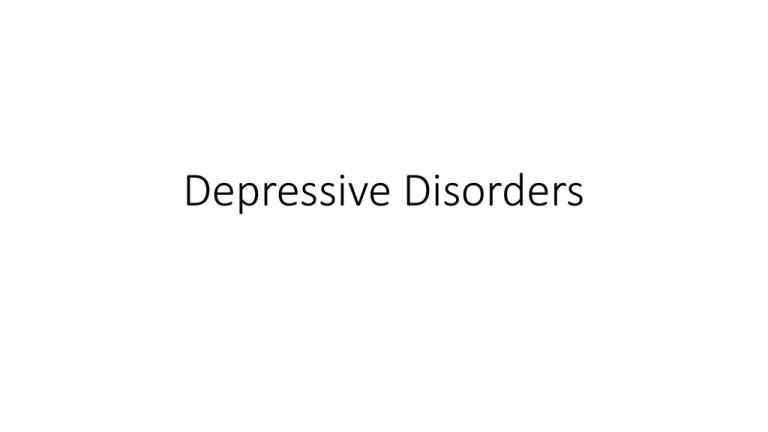
Depressive Disorders Objectives • At the end of this lesson, the SPN will: • 1. Define mood and affect • 2. Define and differentiate depression, euphoria, and mania • 3. Define and describe the s/s, incidence and treatment for major depressive disorder, seasonal affective disorder, dysthymia, and premenstrual dysphoric disorder • 4. Define and describe the s/s, incidence, and treatment for Bipolar disorder • 5. Apply the nursing process to a client with Bipolar Disorder Mood and Affect Defined • Mood is an emotion that is prolonged to the point that it colors an individual’s entire psychological thinking. The feelings are changeable depending on the person’s perception of sensory stimuli. • Affect describes the facial expression an individual displays in association with the mood (e.g. smiling when happy, grimacing when angry) • Alterations in mood can range from mild to severe Mood alterations • When the mood alterations are mild, the person may experience minor changes in daily routine with minimal impairment in functioning • Severe mood alterations can result in significant impairment of the person’s ability to function • The prolonged inability to regain a sense of emotional balance is considered abnormal. A depressed mood is one in which sadness is intensified and continues longer than would normally be expected in a particular situation Depression, Euphoria, Mania • Depression is described as a persistent and prolonged mood of sadness that extends beyond 2 weeks’ duration or longer • In the depressive disorders, there is a distinctive change in the affect and cognition, with the sadness being severe enough to interfere with the individual’s functional activity • In contrast, excessive feeling of happiness or elation is seen in euphoria • A euphoric state can escalate to a frenzied unstable mood of mania in which the person may be out of touch with reality. Major Depressive Disorder • Occurs when a person experiences a depressed mood or loss of interest in most activities for most of each day for a period of 2 weeks • Can occur as a single episode or recurrent depressive episodes • The depressive episode may have a precipitating circumstance, such as chronic pain, loss of a job, lack of support system, financial difficulties, or conflict with a friend or loved one Major Depressive Disorder • Incidence and Etiology• More common in females and those who have a familial tendency for the disorder • Adolescents between 14 and 16 and adults older than 65 have a higher incidence • May develop over days or weeks and last for several months • A common theory about the cause of major depression is that it is related to functional deficits of neurotransmitters in the brain that lead to a chemical imbalance Major Depressive Disorder- Signs and Symptoms • • • • • • • • Mood of worry, anxiety, hopelessness and worthlessness Guilt and self-blame Crying episodes Fatigue, Anergia (a marked decrease in energy level) Sleep disturbances Weight and appetite changes Decreased sex drive Poor concentration and memory lapse Signs and Symptoms Con’t. • • • • • • • Decreased productivity Difficulty making decisions Irritability Extreme sadness with sad affect Physical complaints Anhedonia- a lack of pleasure in things previously enjoyed Thoughts of death or suicide Major Depressive Disorder-Treatment • CBT • Antidepressants-SSRI’s, tricyclics Major Depressive Disorder with Seasonal Pattern • Indicates that episodes mostly begin in fall or winter and remit in spring. • Characterized by anergia, hypersomnia, overeating, weight gain, and craving for carbohydrates • Responds to light therapy Persistent Depressive Disorder (Dysthymia) • A recurrent state of depression over a period of at least 2 years • Depressive symptoms become a part of the person’s day-to-day experience, never disappearing for more than 2 months at a time • The symptoms of persistent depressive disorder are less severe than those of major depression, but the disorder tends to be more chronic Persistent Depressive Disorder (Dysthymia) • Incidence and Etiology • Occurs two to three times more frequently in women than men • More likely to occur in first-degree biologic relatives with depressive disorders • There is usually an early-onset beginning anytime from childhood through early adulthood Persistent Depressive Disorder (Dysthymia)Signs and Symptoms • Chronic depression symptoms • Feelings of inadequacy, failure, emptiness • Hopelessness • Negativism-a learned sense of helplessness characterized by feelings of failure, and emptiness that often results in a pessimistic attitude toward most aspects of the person’s existence • Maladaptive coping skills • Sleep difficulties Persistent Depressive Disorder (Dysthymia)Signs and Symptoms • • • • • Increased or decreased appetite Fatigue Low self-esteem Difficulty concentrating Decreased decision-making ability Dysthymic Disorder- Treatment • • • • Psychotherapy Behavioral Therapy Group therapy Pharmacologic treatment- SSRI’s, tricyclics Premenstrual Dysphoric Disorder • A condition in which a woman has severe depression symptoms, irritability, and tension before menstruation • Symptoms typically occur about 5 to 11 days before a woman starts her monthly menstrual cycle • Symptoms usually stop when, or shortly after, her period begins Premenstrual Dysphoric Disorder • Etiology and Incidence • Many women who have this disorder, also have anxiety, severe depression, and depressive disorder with a seasonal pattern • Other factors that may play a role include: alcohol or substance abuse, thyroid disorders, overweight, having a mother with the disorder, lack of exercise Premenstrual Dysphoric Disorder • Signs and Symptoms • Lack of interest in daily activities and relationships • Fatigue or low energy • Sadness or hopelessness, possibly thoughts of suicide • Anxiety • Out of control feeling • Food cravings or binge eating • Mood swings with bouts of crying • Panic attacks Premenstrual Dysphoric Disorder • Signs and Symptoms Con’t. • Irritability or anger that affects other people • Bloating, breast tenderness, headaches, and joint or muscle pain • Problems sleeping • Trouble concentrating Treatment of Depressive Disorders • Treatment involves a combination of pharmacological and psychotherapeutic approaches • Antidepressants • Individual psychotherapy to address past losses and stressors • Short-term cognitive behavioral therapy to develop new strategies to alter negative thinking • Group therapy to address socialization and poor self-esteem • For severe depression, ECT is sometimes suggested Treatment of Depressive Disorders Con’t. • Alternative Treatments: • Light Therapy- special lights are used for certain amounts of time during the day • Herbal and Nutritional Therapy-Avoiding caffeine, sugar, and alcohol or adding servings of whole grains and vegetable may help a person with mild depression • Herbs such as kava, gingko, and fish oil have been shown to provide antidepressant effects in some patients with mild depression Bipolar Disorder • Formerly known as manic depression • There is a brain dysfunction that causes abnormal and erratic shifts in mood, energy, and functional ability • The episodes of alternate changes between extreme moods, ranging from high manic episodes (euphoric, excessively happy, high energy) to low depressive periods may occur rapidly, may be intermixed with periods of normal functioning, or these can occur simultaneously in a missed episode Bipolar Disorder • The rapid shifts in mood in a short period of time are known as labile, or alternating from euphoria to dysphoria and irritability • According to the DSM-5 criteria for bipolar disorder, the mood changes must be accompanied by persistently increased activity or energy levels that are obvious to those observing the person. • The frequency of the mood swings between the two states is unpredictable and varies from person to person • The severity of the symptoms may vary from mild to severe Bipolar Disorder • If the person has four or more mood shifts within a year, the person is said to be rapid cycling. This feature is more common in later stages of the illness • Incidence and Etiology• There seems to be a genetic factor that is shown by the familial pattern of illness • Evidence has linked bipolar symptoms to changes in the chemical neurotransmitters in the brain • Substance abuse and stressful life events have also been linked to the episodes Bipolar Disorder • Incidence and Etiology • Women are at greater risk than men for developing manic episodes, which can occur at any time • The average age of onset for a first manic episode is in the early 20’s, but it can be as early as adolescence and as late as age 50 • Manic episodes that occur in adolescence may lead to school failure, behavioral problems, and substance abuse Bipolar Disorder • Signs and Symptoms• The first indications may be a state of mild to moderate mania called hypomania that lasts for a period of at least 4 days. • During the hypomania phase the person will have the following signs and symptoms: • Unusually cheerful with excessive energy and the ability to keep going long after others are exhausted • The need for sleep decreases to 3 or 4 hours • There is an obvious inflated self-esteem or feeling of grandiosity during which time the person may experience hallucinations or delusional thinking Bipolar- Signs and Symptoms Con’t. • During hypomania: • An increase in goal-directed activity but with increased irritability and moodiness • The person usually talks incessantly with a flight of ideas or jumping from one subject to another, and may describe thoughts as racing or pressured • Attention is easily distracted to things in the environment that are insignificant • Irresponsible, impulsive behavior. • A preoccupation with seductive thoughts often leads to sexual promiscuity Bipolar- Signs and Symptoms Con’t. • During hypomania: • The changes in mood are obvious to others but not usually severe enough to require hospitalization • The person in hypomania does not experience psychotic symptoms of delusions or hallucinations Bipolar- Signs and Symptoms Con’t. • During full-blown manic episodes: • Symptoms are more extreme and pronounced • Elevated mood lasts for at least a week and causes disruption in the person’s ability to function- little need for sleep • The person’s lack of insight and excessive level of activity predispose him or her to a dangerous and volatile psychotic state • The person may be offensive and violate the rights of others • When his or her wishes are not fulfilled, the mood may shift from extreme aggressive euphoria to extreme aggressive irritability Bipolar- Signs and Symptoms Con’t. • During full-blown manic episodes: • The person may perceive injustice and have delusional thoughts of persecution that a threat of harm exists • The constant shift in attention from one thought to another is seen in flight of ideas • Words may be strung together in rhyming phrases or clang associations that have no connected meaning. • The person projects an expanded thought pattern of grandiosity with false beliefs of wealth, power, and identity Bipolar- Signs and Symptoms Con’t. • During full-blown manic episodes: • Auditory and visual hallucinations may occur during the height of the manic episode • Females may dress bizarrely with bright flamboyant colors, excessive jewelry, and inappropriate makeup • Hygiene is often neglected as the thought processes escalate and activity accelerates • Items such as magazine pictures, containers, and food may be collected and stockpiled as the hyperactivity absorbs the person’s time Bipolar Depressive Phase Symptoms • Low self esteem • Overwhelming inertia (sluggishness, a lack of activity) • Social withdrawal • Feelings of hopelessness, and apathy • Difficulty concentrating or thinking clearly (without obvious disorientation or intellectual impairment) • Psychomotor retardation (sluggish physical movements and activity) • Slowing of speech and responses • Sexual dysfunction Depressive Symptoms Con’t • Sleep disturbances (such as difficulty falling or staying asleep or earlymorning awakening) • Decreased muscle tone • Weight loss • Slow gait • constipation Bipolar Treatment • Consists of drug therapy. Lithium is highly effective in both preventing and relieving manic episodes. It curbs accelerated thought processes and hyperactive behavior without the sedating effect of antipsychotic drugs. • The MD may also prescribe Depakote for rapid cyclers or for patients who can’t tolerate lithium. • Tegretol may also be prescribed for treating mania. • Lamotrigine (Lamictal) may be prescribed. ***Monitor for StevensJohnson Syndrome) • Newer anticonvulsants- Topamax and Trileptal may be prescribed • Anxiolytics such as Klonopin and Ativan are useful for acute mania Bipolar Treatment • Second generation antipsychotics- Zyprexa, Risperdal, Abilify, and Geodon may be prescribed to help with insomnia, anxiety, and agitation • ECT is used to subdue severe manic behavior • Psychotherapy • Cognitive Behavioral therapy • Family-focused therapy • Support groups Nursing Care-Manic Phase • Provide for the patient’s physical needs. Involve him in activities that require gross motor movements • Encourage the patient to eat. Offer high calorie finger foods, sandwiches, and cheese and crackers to supplement his diet. • Provide clear firm limits. Clearly define what is expected and what is not allowed • Maintain safety Nursing Care Con’t • Suggest short daytime naps, and help with personal hygiene. As symptoms subside, encourage him to assume responsibility for personal care • Provide diversionary activities suited to a short attention span • Maintain a calm environment and protect the patient from over-stimulation, such as from large groups, loud noises, etc. Nursing Care Con’t • Provide emotional support and set realistic goals for behavior • Tactfully divert the conversation if it becomes intimately involved with other patients or staff • Avoid reinforcing socially inappropriate or suggestive comments • Set limits for the patient’s demanding, hyperactive, manipulative, and acting-out-behaviors Nursing Care Con’t • Collaborate with other staff members regarding the plan of care • Monitor the medication regimen. Advise the patient that Lithium needs to be taken with food or after meals to avoid stomach upset Nursing Care-Depressive Phase • Provide for the patient’s physical needs. If he’s too depressed to care for himself, help with personal hygiene • Encourage him to eat, or feed him if necessary. If constipated, add high-fiber foods to his diet; offer small, frequent meals; and encourage physical activity • To help the patient sleep, give back rubs or warm milk at bedtime Nursing Care Con’t • Provide a structured routine • Avoid overwhelming the patient with expectations • Remove harmful objects from the patient’s environment • Observe the patient closely, and strictly supervise his medications • If the patient is taking an antidepressant, watch for signs and symptoms of mania Bipolar Disorder- Nursing Diagnosis • What would be an appropriate nursing diagnosis for a patient that presents with bipolar disorder? • BE AWARE THAT YOU NEED TO RECOGNIZE WHAT STATE OF BIPOLAR THE PATIENT IS IN. THE NURSING DIAGNOSIS’ FOR DEPRESSION VS. THE NURSING DIAGNOSIS’ FOR MANIA WILL BE DIFFERENT!!!!!! Bipolar Disorder- Expected Outcomes • What are the expected goals or outcomes for the client in a depressed state? • What are the goals for the client in a state of hypomania or mania? Bipolar Disorder- Nursing Interventions • What are the interventions for a client in a depressed state? • What are the interventions for a client in a state of mania or hypomania?

